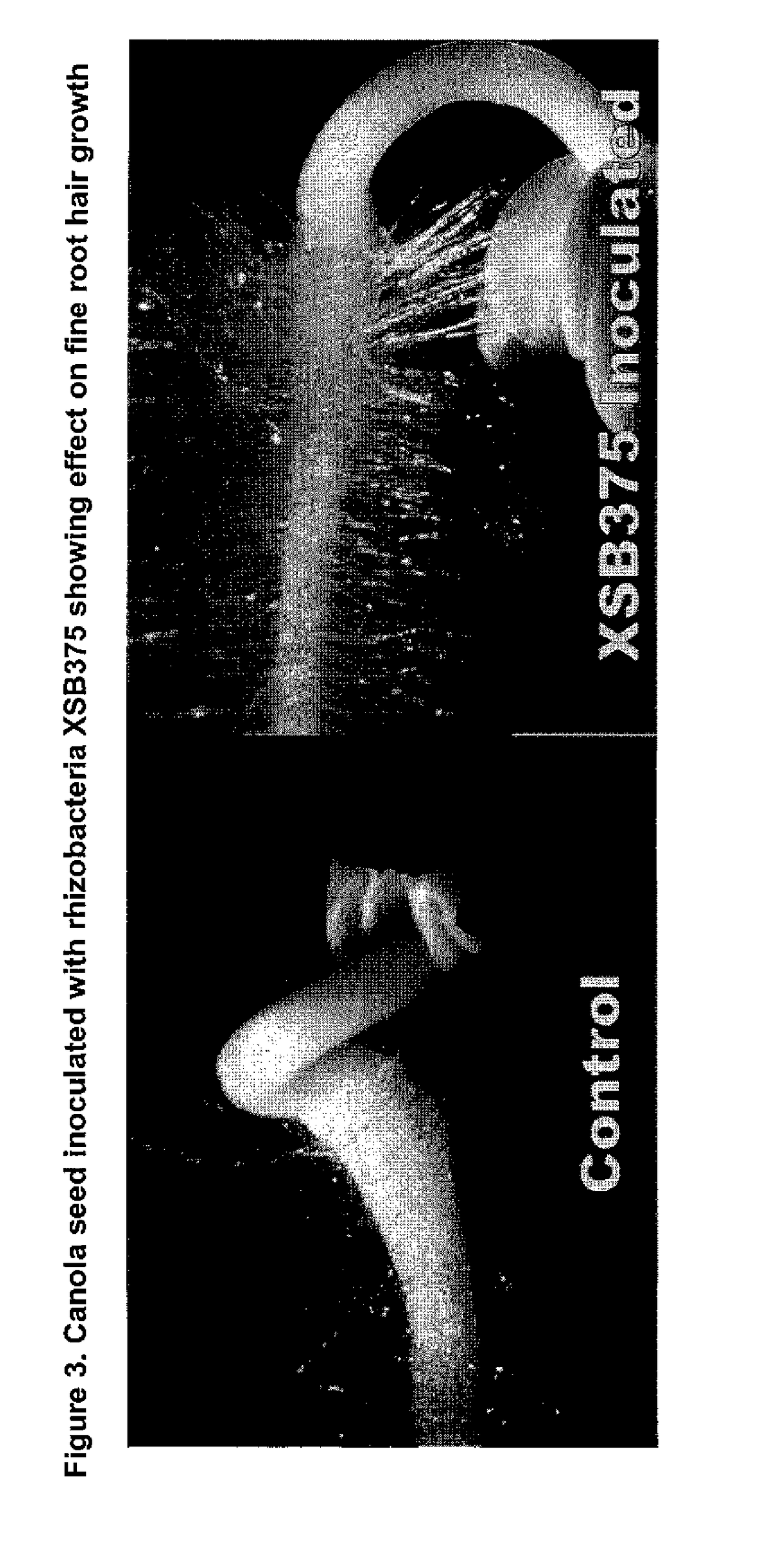Phosphate Solubilizing Rhizobacteria Bacillus Firmus as Biofertilizer to Increase Canola Yield
a technology of biofertilizer and rhizobacteria, which is applied in the field of biofertilizer and plant inoculants, can solve the problems of reducing the population of higher-order aquatic plants and animals, phosphorus is typically insoluble or poorly soluble in soil, and the application of p fertilizer to crop fields is excessive, so as to achieve the effect of increasing plant growth and yield
- Summary
- Abstract
- Description
- Claims
- Application Information
AI Technical Summary
Benefits of technology
Problems solved by technology
Method used
Image
Examples
example 1
of Phosphate Solubilizing Rhizobacteria
[0116]Bacteria were isolated from the canola rhizosphere soil and rhizoplane from Elm Creek, Manitoba by a serial dilution technique and spread plate method. The laboratory basal media used was trypticase soy agar (TSA, 1 / 10 strength) media and the plates were incubated for 3 days at 28° C. All the rhizobacterial isolates were selected to represent distinct types based on colony morphology that includes colony form, elevation, opacity and pigment production. Rhizobacterial isolates were restreaked on TSA plates, checked for purity and stored on TSA slants at 4° C. Presumptive phosphate solubilizing rhizobacteria were isolated by streaking the isolates on modified PDYA (potato-dextrose yeast extract agar) media plates (de Freitas et al., 1997). The modified media consists of the PDYA media containing freshly precipitated calcium phosphate (i.e. 50 ml sterile 10% (wt / vol) K2HPO4 and 100 ml sterile 10% (wt / vol) CaCl2) were added per litre of steri...
example 2
on Effect on Canola Seed Emergence
[0118]Bacterial strain XSB375 was grown in 100 ml of TY broth for 48 hours on a rotary shaker. Bacterial cell culture was concentrated by centrifugation and washed with distilled water and suspended in NaCl solution. Surface disinfected canola seeds were then inoculated with the bacterial suspension. Inoculated seeds were placed on agar plates to observe the bacterial effect on canola seed emergence (Table 1). A set of uninoculated seeds were also placed on agar plates as control. Inoculated seeds were also planted on soil pots and growth pouches to examine bacterial effect in soil (FIG. 2) and growth pouch (Table 2). Results illustrated that canola seeds inoculated with strain XSB375 enhanced seed emergence on agar plate, in soil and in growth pouch compared to control (Table 1 and 2, FIGS. 2 and 3).
example 3
on Effect on Canola Growth Promotion in Growth Pouch
[0119]Surface disinfected canola seeds were inoculated with the bacterial suspension. Inoculated seeds were planted in growth pouches to examine the bacterial effect on canola growth promotion (FIG. 4). A set of uninoculated seeds were also placed in growth pouch as control. Plant hypocotyl and root lengths were measured after 7 days (FIG. 5). Results illustrated that canola seeds inoculated with strain XSB375 enhanced canola growth promotion in growth pouch compared to control (FIGS. 4 and 5). The bacterial strain XSB375 enhanced the canola root (mean length 14.26 cm) and hypocotyl (mean length 7.11 cm) growth considerably in comparison to control root (5.94 cm) and control hypocotyl (mean length 5.14 cm).
PUM
| Property | Measurement | Unit |
|---|---|---|
| size | aaaaa | aaaaa |
| mean length | aaaaa | aaaaa |
| mean length | aaaaa | aaaaa |
Abstract
Description
Claims
Application Information
 Login to View More
Login to View More - R&D
- Intellectual Property
- Life Sciences
- Materials
- Tech Scout
- Unparalleled Data Quality
- Higher Quality Content
- 60% Fewer Hallucinations
Browse by: Latest US Patents, China's latest patents, Technical Efficacy Thesaurus, Application Domain, Technology Topic, Popular Technical Reports.
© 2025 PatSnap. All rights reserved.Legal|Privacy policy|Modern Slavery Act Transparency Statement|Sitemap|About US| Contact US: help@patsnap.com



